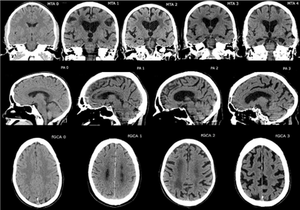Cerebral Atrophy
Original Editor - Rahma Ahmed Ahmed Bahbah
Top Contributors - Rahma Ahmed Ahmed Bahbah and Lucinda hampton
This article or area is currently under construction and may only be partially complete. Please come back soon to see the finished work! (20/12/2023)
Introduction[edit | edit source]
Cerebral atrophy or Brain atrophy is a condition associated with a reduction of cerebrum volume by loss of neurons and their connections so it might seem like it's a common feature of brain diseases .[1]
Brain atrophy is common in elderly due to aging process; known as senile degeneration. However, brain atrophy can also be observed in the pediatric age group, where it carries forward the small volume of the brain into middle age. It is important to note that some atrophic changes may be reversed during childhood.
In the normal aging, brain atrophy tends to be accelerated by the presence of other risk factors such as high blood pressure, cardiac disease, diabetes mellitus, smoking practice, and regular alcohol intake. It's been observed that glycated hemoglobin (HbA1c) was the most significant risk factor for accelerating of brain atrophy, which is average blood sugar levels over a period of weeks/months.
Types[edit | edit source]
Cerebral atrophy is classified into two categories. According to the affected brain area, it's global and focal. And according to volume loss distributed zone, it's central or cortical.
In central atrophy, it's found that white matter volume loss is more than grey matter, and the opposite is seen in cortical atrophy.
There's also brain hemiatrophy in which volume loss involves one hemisphere.
Causes[edit | edit source]
There are many factors cause atrophy;[1]
- Aging
- Infections of central nervous system (CNS)
- Nutritional deficiency
- Metabolic and endocrine causes
- Traumatic causes
- Drug induced brain atrophy
- Radiation induced brain atrophy
- Increased intracranial pressure
- Perinatal and birth injury induced atrophy
- Neurodegenerative diseases causing brain atrophy
- Other causes
Clinical picture[edit | edit source]
There are various clinical features of cerebral atrophy like poor levels of intelligence especially in growing children. Memory loss is common among elderly individuals. Elderly patients with brain atrophy often experience acute confusional state.
Brain atrophy can result in loss of functional recovery following an infarct, which may also lead to death due to poor brain functioning.
Conditions[edit | edit source]
Brain atrophy does not always occur in isolation; unlike some other conditions such as leukoaraiosis and stroke are known to accompany brain atrophy.[1]
Some conditions that featured with cerebral atrophy are; Alzheimer's disease, Cerebral Palsy , Multiple sclerosis, Epilepsy, Pick's Disease, Dementia, ALS, Prion disease, Encephalitis, AIDS, Neurosyphilis.
Neuroimaging[edit | edit source]
The features appear in imaging may include the following;
- Widening of cortical sulci
- Enlargement of ventricles
- Thinning of cortex
- Shrinking of hippocampus
Management[edit | edit source]
As we mentioned before, cerebral atrophy can be a feature for many conditions, although, There isn't no cure for cerebral atrophy. However, treatment is depend on each condition causing the atrophy and management as a whole.
For example,
References[edit | edit source]
- ↑ 1.0 1.1 1.2 Sungura R, Onyambu C, Mpolya E, Sauli E, Vianney JM. The extended scope of neuroimaging and prospects in brain atrophy mitigation: a systematic review. Interdisciplinary Neurosurgery. 2021 Mar 1;23:100875.







